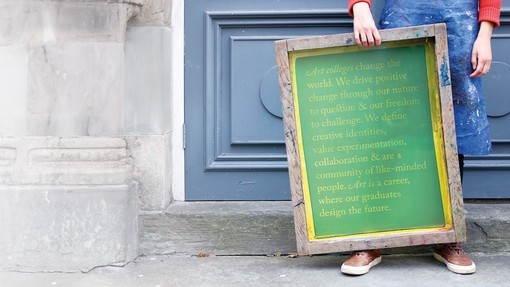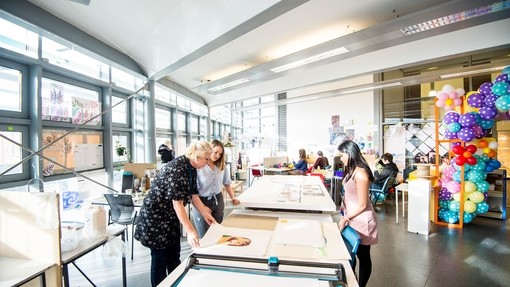Photography

Unpeeled: Complexities of the Human Experience
In an age increasingly characterised by an emphasis on surface appearances over substance, and external attributes over intrinsic qualities, it would be easy to become disconnected or apathetic to the sense of depthlessness that pervades the contemporary condition. Artists have and will always continue to use the contemporary contexts that surround them as the raw material for peering beyond the façade of appearance to the complexities of the human experience that lies beneath.
Unpeeled brings together a collective of artists from the graduating cohorts of BA (Hons) Fine Art: Studio, Site and Context, BA (Hons) Documentary Photography and Visual Activism, and BA (Hons) Photography in the Arts programmes at Swansea College of Art, UWTSD. The artists involved reflect upon their personal and collective experiences, exploring themes of history, the Anthropocene, trace, memory, myth, identity, technology and politics through an embracing of the ever-expanding dialogue between Fine Art and Photographic practice.
Staff of the Fine Art and Photography programmes at Swansea College of Art, UWTSD wish to thank the Unpeeled collective for the harmonious organisation and deft execution of their exhibition and congratulate them on producing such engaging bodies of work. We wish them every success with their future endeavours.
Ryan L. Moule
Head of Undergraduate Photographic Studies
Swansea College of Art, UWTWD.
Professor Sue Williams
Head of Fine Art: Studio, Site, Context
Swansea College of Art, UWTSD.
Class of '24
Our Work
BA Hons Documentary Photography and Visual Activism
Dominic Brewster’s practice explores and responds to space and architecture. Actively attributing works to the collaborative initiative, Curb Collective, his practice currently focuses on documenting life, capturing skate-surf subculture, and the experiences within both new and familiar environments. Brewster’s work is introspective and explorative, immersed in the process of observation of his surroundings – he engages with all senses to distil the essence of a ‘flow state’, through an embracing of the present.
- Instagram @ffotobrewst

Ahmed’s immersive installation, (احساس – Ehsaas), explores the internal struggle between the primal and rational aspects of the human mind and our connection to the natural around us. Through a multi-sensory experience incorporating photography, ceramics, projections, sound, and sculpture, Zobia invites viewers to engage with the concept of Sentire – to feel. Thanks to its interactive character, participants are encouraged to take part in the process of the installation’s disintegration by cutting away at a beaded curtain to unveil the image beneath. The ceramic bowls which catch the beads are crafted with clay from the Kashmir region and symbolise the comfort and support that home provides.

BA Hons Photography in the Arts
Chloe Marie’s practice focuses on three main contexts – motherhood, place and her relationship with her daughter. Marie’s ongoing body of work “What Mothers Do Best“ is an exploration of unconditional love. Using black and white photography, the body of work documents the family dynamics of growth, both physically and conceptually.
- Instagram @chloeemariee_photo
- Website Chloe Marie Photo

Ellie Thomas focuses on symbolising how individuals handle and manage an undiscovered illness that has a significant impact on their lives. Using a medium that traditionally renders the world as fixed and static, Thomas explores the therapeutic possibilities for photography to show us a world in fragments.
- Instagram @capturingmyphotography
- Website Ellie Thomas Photography

‘An irreversible chronic dissociation of the physical body, resulting in it slowly fading away’ (Sportskeeda.com, A, Halder. 2024)
Holly Morris-Price’s practice explores the psychological effects of shape and colour to create an experience for the audience that allows them to feel detached from the current reality we live in.
By taking inspiration from the games Morris-Price plays, she creates site-situated works that create relationships between reality and abstraction.
‘In time, the world becomes blurry, and the body ultimately fades away’ (Sportskeeda.com, A, Halder. 2024)
- Instagram @kinophtgpy

Sheba Yashica’s work takes interest in the nuances and ambiances of the urban environment, within which we are presented with countless non-spaces. Typically considered to be aesthetically unpleasing, these fringes and corners of man-made spaces are still able to occupy our conscience, even if only for fleeting intervals of time. By intentionally engaging with these spaces, Yashica looks to explore the atmosphere that is created and evoked by these often overlooked and neglected fragments of our built environment’s make-up.
- Instagram @shebayashica
- Website Sheba Yashica

Ollie Stewart’s photographic series, Changing channels delves into the complex history of queer representation in media, a landscape often dominated by stereotypes and invisibility. This photographic series explores the impact of these historical portrayals on the formation of contemporary queer identities.
Each image features a member of the LGBTQ+ community in a place they feel comfortable, juxtaposed with a vintage television on their heads. The static crackle and grainy image reflect both the fragmented history and the ongoing search for self-understanding within these limited portrayals.
It celebrates the act of unearthing forgotten narratives while acknowledging the need for a more nuanced and authentic portrayal of queer experiences across time. Changing channels is a call to action, urging viewers to engage with the past and create a future with richer, more diverse representations of LGBTQ+ identities.
- Instagram @ols_images
- Website Ol’s Images

Rosie Kent’s work follows their diary entries during their journey of self-discovery concerning their gender. Kent’s self-portraits capture the struggles of not conforming to societal standards and gender roles and how we have been brought up in a world that has strict expectations of how you should behave based on the sex you were assigned at birth. Kent’s work looks deeper into the negative impact these standards can have on a person’s mental and physical state when they feel pressured to comply with the modern societal expectations of gender.
- Instagram @ghoulishpics




